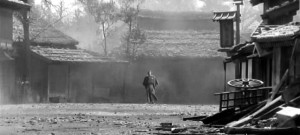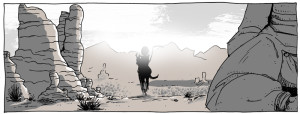The Long John Primer, Part 2
The first week of Long John updates hangs overhead and, naturally, I begin to worry. I want to explain everything before the first page updates; I want to immerse every reader into Long John’s world from the get-go; I want you to know everything about everybody with all the research and changes that have happened since I started putting this thing to paper. But that’s not how stories work. I only dole out pieces at a time. Some pieces you’ll never see, and that’s okay.
What I will do, however, is let you in on a little bit of the background, inspiration, and motivation that has made Long John what it is. For the next four days, you’ll be getting chunks of what helped make Long John into the comic it is (or will be).
2. The Kurosawa Factor
Among my friends and family, it’s well-known that I am a huge fan of the Japanese director, Akira Kurosawa. Well, that’s actually a bit bold. More specifically, I am a die hard fan of his 1961 samurai film, Yojimbo. Usually, when asked, I say that Yojimbo is my favorite film of all time. That’s how dear it is to me. And while Long John is not a re-telling of Yojimbo, it’s hard to discount that there will definitely be Yojimbo-esque elements popping up throughout the story. The influence of Yojimbo was further driven in when considering how many Westerns and western cinema it influenced (more on Yojimbo’s influence in tomorrow’s post).
Yojimbo was a movie I saw at a fairly young age and it blew me away for a few reasons. First, it was probably the first black-and-white movie I didn’t fall asleep to while watching it. Second, its bleak and striking visuals hit a resonance within me that I couldn’t shake and everything I’ve done has a similar aesthetic driving it (to a certain extent). Kurosawa is also a master of frame composition and if there’s anything I’ve gone back to while developing Long John, it would be to examine how he sets up shots.
Another aspect that can’t be ignored is the portrayal of the protagonist, Sanjuro, as played by the incomparable Toshiro Mifune. One second he’s stoic, in another he’s sarcastic, in another he’s murderous, all of it is carried with a poise and comfort that feels nothing short of real. Mifune was a big influence on me, personally, that helped me get more comfortable in my own skin, but his affectations have surely already bled into Long John. In particular, later on you’ll see my interpretation of his character’s tendency to tuck his arms into the wide sleeves of his kimono. Keep an eye out for it.
As you’ll see early on, Long John borrows Yojimbo’s tone quite a bit in its balance of melodrama and dry, dry comedy. Yojimbo is a funny, violent, quiet, and profound work that I don’t necessarily expect to emulate, though if I were even to hook a finger around the lowest rung I’ll feel I’ve made something special.
And that’s my riff on Kurosawa’s influence on Long John. Also, read about The Eastern Sierra Nevada Factor, The Hammett Factor, The Western Factor, The Heavy Metal Factor, and The Indie Comics Factor.



Discussion (8) ¬